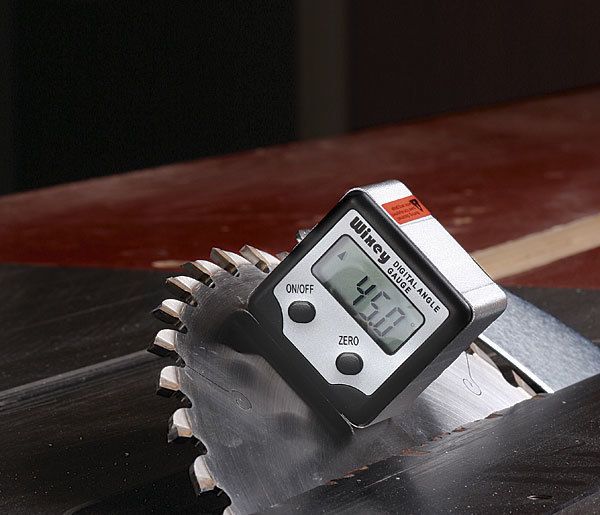Digital Angle Gauges
Little electronic gauges go anywhere you need a reading
Synopsis: Digital angle gauges, also called inclinometers, measure the angle of tilt after being zeroed to a reference surface. They have a magnetized base that makes them easy to attach to most machine tables, fences, and blades in the shop. Woodworkers use them for tasks that range from setting the bevel on a sawblade to setting up a honing guide. How accurate are they? Are they better than a good square, drafting triangles, or a bevel gauge? We tested a number of them to find out.
If you haven’t seen them before, digital angle gauges, also called inclinometers, measure the angle of tilt after being zeroed to a reference surface. They have a magnetized base that attaches easily to most machine tables, fences, and blades in the shop.
Wixey was the first to market one of these magic little cubes to woodworkers, in 2006, and other brands and models followed. Soon they were appearing in the pages of Fine Woodworking as woodworkers found a host of uses for them, from setting the bevel on a sawblade to setting up a honing guide.
The appeal is powerful: having one easy-to-read digital gauge that will guarantee any angle, from square to level to everything in between. But I found myself wondering exactly how accurate these little angle gauges are. Are they better than my usual tools for setting angles: a good square, drafting triangles, or a bevel gauge?
I started by interviewing FWW authors who use these gauges. I also reached out to our online readers in a recent blog. I heard opinions on all sides, and discovered uses aplenty, but no one had done any real testing.
Accurate to a point (0.1 actually)
My next move was to order all the digital angle gauges I could find. There are a dozen or more, but not all are relevant to woodworkers. I stuck to those with magnetic bases, small enough to fit on the part of an angled tablesaw blade that sticks up above the throat plate.
As soon as the gauges arrived, I gathered with my fellow editors and started designing tests (see “Testing reveals two favorites,” p. 77). It didn’t take long to figure out which ones were the most accurate, and just how good those are. The most sensitive models are accurate to plus or minus 1⁄10 of a degree. But what does that mean in real woodworking terms?
Ultimately we determined that these digital gauges are best for any place where a good square won’t work. They will get you extremely close to the perfect setting, but not quite as close as bending over and looking for that sliver of light along the edge of a square. For angles other than 90°, however, a digital angle gauge is a wonderful tool. It will get you at least as close as a drafting triangle will, for example, and closer than the protractor head you can buy for most combo squares.
In any case, test cuts are the only real way to guarantee success. But it is a real benefit to be able to get a machine setup extremely close to start with, so just a little bump one way or the other delivers a gapfree joint.
For the full article, download the PDF below:
Fine Woodworking Recommended Products

Veritas Precision Square

Bahco 6-Inch Card Scraper

Starrett 12-in. combination square























Log in or create an account to post a comment.
Sign up Log in